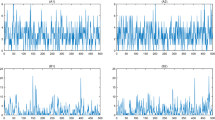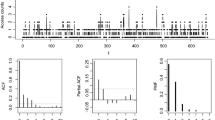Abstract
To accurately and flexibly capture the dispersion features of time series of counts, we introduce the generalized Poisson thinning operation and further define some new integer-valued autoregressive processes. Basic probabilistic and statistical properties of the models are discussed. Conditional least squares and maximum quasi likelihood estimators are investigated via the moment targeting estimation methods for the innovation free case. Also, the asymptotic properties of the estimators are obtained. Conditional maximum likelihood estimation for the parametric cases are also discussed. Finally, some numerical results of the estimates and two real data examples are presented.











Similar content being viewed by others
Notes
Here the innovation free means the process is defined with a free type of innovation, i.e., the process is defined with no assumption of the distribution type of the innovations.
References
Al-Osh MA, Alzaid AA (1987) First-order integer-valued autoregressive (INAR(1)) process. J Time Ser Anal 8:261–275
Alzahrani N, Neal P, Spencer SEF, McKinley TJ, Touloupou P (2018) Model selection for time series of count data. Comput Stat Data Anal 122:33–44
Billingsley P (1961) Statistical inference for Markov processes. The University of Chicago Press, Chicago
Bourguignon M, Weiß CH (2017) An INAR(1) process for modeling count time series with equidispersion, underdispersion and overdispersion. Test 26:847–868
Chen CWS, Lee S (2017) Bayesian causality test for integer-valued time series models with applications to climate and crime data. J R Stat Soc Ser C 66:797–814
Consul PC (1989) Generalized Poisson distributions: properties and applications. Marcel Dekker, New York
Consul PC, Famoye F (1992) Generalized Poisson regression model. Commun Stat Theory Methods 21:89–109
Consul PC, Famoye F (2006) Lagrangian probability distributions. Birkhäuser, Boston
Consul PC, Jain GC (1973) A generalization of the Poisson distribution. Technometrics 15:791–799
Cox DR (1981) Statistical analysis of time series: some recent developments [with discussion and reply]. Scand J Stat 8:93–115
Freeland RK (1998) Statistical analysis of discrete time series with applications to the analysis of workers compensation claims data. University of British Columbia, Canada Ph.D. Thesis
Fukasawa T, Basawa IV (2002) Estimation for a class of generalized state-space time series models. Stat Probab Lett 60:459–473
Hall P, Heyde CC (1980) Martingale limit theory and its applation. Academic Press, New York
Klimko LA, Nelson PI (1978) On conditional least squares estimation for stochastic processes. Ann Stat 6:629–642
Latour A (1998) Existence and stochastic structure of a non-negative integer-valued autoregressive process. J Time Ser Anal 19:439–455
Li Q, Zhu F (2018) Mean targeting estimator for the integer-valued GARCH(1,1) model. Stat Pap. https://doi.org/10.1007/s00362-017-0958-9
Li H, Yang K, Wang D (2017) Quasi-likelihood inference for self-exciting threshold integer-valued autoregressive processes. Comput Stat 32:1597–1620
Li H, Yang K, Zhao S, Wang D (2018) First-order random coefficients integer-valued threshold autoregressive processes. AStA Adv Stat Anal 102:305–331
McKenzie E (1985) Some simple models for discrete variate time series. JAWAR J Am Water Resour Assoc 21:645–650
Pedeli X, Davison AC, Fokianos K (2015) Likelihood estimation for the INAR(\(p\)) model by saddlepoint approximation. J Am Stat Assoc 110:1229–1238
Ristić MM, Bakouch HS, Nastić AS (2009) A new geometric first-order integer-valued autoregressive (NGINAR(1)) process. J Stat Plan Inference 139:2218–2226
Ristić MM, Nastić AS, Bakouch HS (2012) Estimation in an integer-valued autoregressive process with negative binomial marginals (NBINAR(1)). Commun Stat Theory Methods 41:606–618
Schweer S (2016) A goodness-of-fit test for integer-valued autoregressive processes. J Time Ser Anal 37:77–98
Schweer S, Weiß CH (2014) Compound Poisson INAR(1) processes: stochastic properties and testing for overdispersion. Comput Stat Data Anal 77:267–284
Serfling RJ (1980) Approximation theorems of mathematical statistics. Wiley, New York
Shi H, Wang D (2014) An approximation model of the collective risk model with INAR(1) claim process. Commun Stat Theory Methods 43:5305–5317
Steutel F, van Harn K (1979) Discrete analogues of self-decomposability and stability. Ann Probab 7:893–899
Wedderburn RWM (1974) Quasi-likelihood functions, generalized linear models, and the Gauss–Newton method. Biometrika 61:439–447
Weiß CH (2008) Thinning operations for modeling time series of counts—a survey. Adv Stat Anal 92:319–343
Yang K, Wang D, Li H (2018a) Threshold autoregression analysis for finite-range time series of counts with an application on measles data. J Stat Comput Simul 88:597–614
Yang K, Li H, Wang D (2018b) Estimation of parameters in the self-exciting threshold autoregressive processes for nonlinear time series of counts. Appl Math Model 54:226–247
Yang K, Wang D, Jia B, Li H (2018c) An integer-valued threshold autoregressive process based on negative binomial thinning. Stat Pap 59:1131–1160
Zhu F (2012) Modeling overdispersed or underdispersed count data with generalized Poisson integer-valued GARCH models. J Math Anal Appl 389:58–71
Acknowledgements
We gratefully acknowledge the anonymous reviewers for their careful work and thoughtful suggestions that have helped improve this article substantially. We also acknowledge the financial supported by National Natural Science Foundation of China (No. 11871028, 11731015, 11571051, 11501241), National Social Science Foundation of China (16BTJ020), Natural Science Foundation of Jilin Province (No. 20180101216JC, 20170101057JC, 20150520053JH), Program for Changbaishan Scholars of Jilin Province (2015010), and Science and Technology Program of Jilin Educational Department during the “13th Five-Year” Plan Period (No. 2016316).
Author information
Authors and Affiliations
Corresponding author
Ethics declarations
Conflict of interest
On behalf of all authors, the corresponding author states that there is no conflict of interest.
Additional information
Publisher's Note
Springer Nature remains neutral with regard to jurisdictional claims in published maps and institutional affiliations.
Appendix
Appendix
The proofs of Proposition 1
Since (i)–(v) are easy to verify, we only prove (vi). By the law of total covariance, we have
Thus, the autocorrelation function \(\rho (h)=\mathrm{Corr}(X_{t},X_{t-h})=\phi (\lambda ,\kappa )^h.\)\(\square \)
The proofs of Theorems 1 and 2
These two theorems can be easily proved by verifying the regularity conditions of Theorems 3.1 and 3.2 in Klimko and Nelson (1978), we omit the details here. \(\square \)
The proof of Theorem 3
This is an application of the \(\delta \)-method; For completeness and reader’s convenience, we refer to Theorem A on p.122 of Serfling (1980) for a proof. \(\square \)
The proof of Theorem 4
First, we suppose \(\varvec{\theta }_2\) is known. Let \(\mathcal {F}_t=\sigma (X_0,X_1,\ldots ,X_t)\) be the \(\sigma \)-field generated by \(\{X_0,X_1,\ldots ,X_t\}\). Denote
By direct calculation, we can see that
and
Thus, \(\{S_t^{(1)}(\varvec{\theta }_2,\varvec{\theta }_1),\mathcal {F}_{t},~t\ge 0\}\) is a martingale. By (C1) and Theorem 1.1 in Billingsley (1961),
Hence, by Corollary 3.2 in Hall and Heyde (1980) and the central limit theorem of martingale, we have,
Similarly, denote \(S_n^{(2)}(\varvec{\theta }_{2},\varvec{\theta }_1)=\sum _{t=1}^n V_{\varvec{\theta }_2}^{-1}(X_t|X_{t-1})(X_t-\phi X_{t-1}-\mu _{\varepsilon })\). Then, we can verify that \(\{S_t^{(2)}(\varvec{\theta }_2,\varvec{\theta }_1),\mathcal {F}_{t},~t\ge 0\}\) is also martingale. Similar to the previous discussion, we have
By Cramer-Wold device, for any \(\varvec{c}^\textsf {T}=(c_1,c_2) \in \mathbb {R}^3\) and \((c_1,c_2)\ne (0,0)\), we have
implying
Now, we replace \(V_{\varvec{\theta }_2}(X_t|X_{t-1})\) with \(V_{\hat{\varvec{\theta }}_2}(X_t|X_{t-1})\), where \(\hat{\varvec{\theta }}_2\) is a consistent estimator of \({\varvec{\theta }}_2\). Then we want to prove that
To prove (A.2), we need to check that
Let \(R_n(\varvec{\theta }_2)=(1/\sqrt{n})S_n^{(1)}(\varvec{\theta }_2,\varvec{\theta }_1)\). Then for any \(\varepsilon >0\) and \(\delta >0\), we have
where \(\widetilde{\varvec{\theta }}_2=(\widetilde{\psi },\widetilde{\sigma }_{\varepsilon }^2)^\textsf {T}, D:=\{|\widetilde{\psi }-\psi _0|<\delta ,|\widetilde{\sigma }_{\varepsilon }^{2}-\sigma _0^2|<\delta \}.\) If \(\hat{\varvec{\theta }}_2\) is a consistent estimator of \({\varvec{\theta }}_2\), then we just need to prove that
By Markov inequality,
where \(m_i~(i=1,2,3)\) denote some finite moments of process \(\{X_t\}\), C is a positive constant. Similar argument can be used for \(1/\sqrt{n}S_n^{(2)}(\varvec{\theta }_2,\varvec{\theta }_1)\). For any fixed \(\varepsilon >0\), letting \(\delta \rightarrow 0\), we get our assertion which in turn establishes (A.2).
Finally, by the ergodic theorem, we have \(\frac{1}{n}\varvec{P}\overset{P}{\longrightarrow }\varvec{T}\). After some algebra, we have,
Therefore,
The proof is complete. \(\square \)
The proof of Theorem 5
Since this proof is similar to the proof of Theorem 4, we omit here. \(\square \)
The proof of Theorem 6
Using the same statements as in the proof of Theorem 3, we can get the conclusion. \(\square \)
Rights and permissions
About this article
Cite this article
Yang, K., Kang, Y., Wang, D. et al. Modeling overdispersed or underdispersed count data with generalized Poisson integer-valued autoregressive processes. Metrika 82, 863–889 (2019). https://doi.org/10.1007/s00184-019-00714-9
Received:
Published:
Issue Date:
DOI: https://doi.org/10.1007/s00184-019-00714-9




